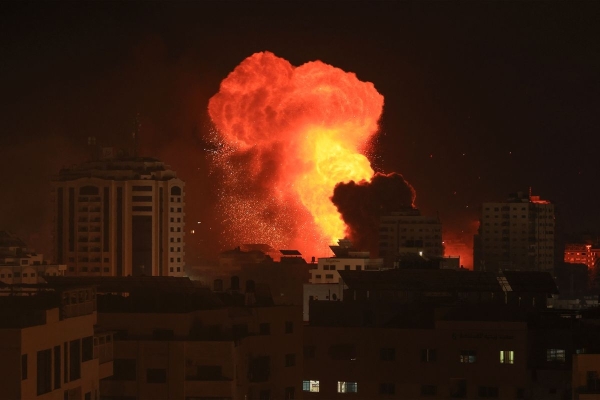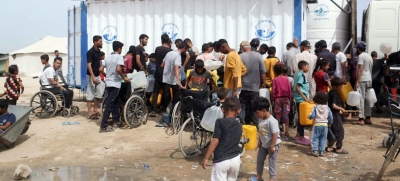Israel says it will place Gaza, the occupied territory it has long blockaded, under a “complete siege” after the weekend’s attack by Hamas.
On Saturday, the Palestinian military group launched intensive attacks from Gaza into Israel. Hamas overwhelmed Israeli military installations, killed over 700 people, kidnapped civilians and reportedly soldiers, and dispatched rockets on Israeli civilians. The government of Prime Minister Benjamin Netanyahu was caught flat-footed despite Israel having the Middle East’s most advanced military and surveillance state.
Now comes the reaction. Israel has called up 300,000 military reservists, and many analysts expect that Israel will send in ground troops. “I ordered a complete siege on Gaza. We are fighting human animals, and we act accordingly,” Israeli Defense Minister Yoav Gallant said on Monday. “As of now, no electricity, no food, no fuel for Gaza.”
But Gaza has been described as living under siege for 15 years, as documented by United Nations experts, journalists, and human rights researchers.
Israel and Egypt control the territory’s border crossings, and Israel controls its access to the Mediterranean Sea and its airspace. More than 2 million Palestinian people reside in a narrow strip, only about twice the area of Washington, DC. The humanitarian crisis that Palestinians have endured in Gaza has been severe even before this latest conflict, and now it will get much worse.
The United Nations reports that so far, 413 Palestinian people in Gaza have been killed and 2,300 have been injured, and those numbers will continue to rise. “Hospitals are overcrowded with injured people, there is a shortage of drugs and consumables, and a shortage of fuel for generators,” Ayman Al-Djaroucha, the Médecins Sans Frontières deputy coordinator in Gaza, told Reliefweb.
The scale of violence has already exceeded the most recent severe conflict between Israel and Hamas. Over a two-week period in May 2021, Palestinian militants killed 12 Israeli civilians and one soldier; Israel’s airstrikes killed more than 250 people, at least 129 of them civilians, in Gaza and injured 1,948 people.
The Israel-Palestine conflict has always been asymmetrical: Israel, a nuclear power, has received tens of billions of dollars of US military aid. This weekend, Hamas ruptured Israeli society with wanton violence and mass killing. But it is the Israeli state that retains the capacity to perpetuate an all-out war on the Gaza Strip. Israel has often responded disproportionately to suicide bombings and rocket attacks from Hamas, partially as a deterrent strategy. The result, however, is an intensity of violence in an occupied territory where residents have nowhere to run, where civilians are regularly killed in Israel’s assaults on Hamas targets.
Now, after suffering its most devastating and brutal attack in decades, Israel is starting to respond. Based on Israeli officials’ rhetoric, this will likely also be more devastating for Gaza than anything that has come before.
“Over the next several days, as the Israeli military bombardment of Gaza runs up the civilian death toll, it will say it is striking what it knows to be military targets,” Yousef Munayyer, a researcher with the Arab Center in DC, says. But Hamas’s surprise attacks “exposed just how much Israel doesn’t know about what is going on in Gaza.”
A besieged Gaza
Hamas, a political and militant faction that the US designates as a terrorist organization for its armed resistance to Israel, took over Gaza in 2007. Since then, Israel has instituted a blockade on the territory that has significantly affected the quality of life: There are extreme rates of poverty; over 60 percent of people need food assistance; and access to health care is extremely limited. UN experts have described it as “collective punishment.” About a quarter of Palestinians in Gaza, and nearly 80 percent of youth, are unemployed.
Israel and Egypt have never allowed enough construction materials into the border crossings under their control to enable Gaza’s rebuilding after conflicts. (During the May 2021 conflict, about 58,000 homes were destroyed, and Israel leveled a 12-story high-rise in Gaza that it said contained Hamas assets but also contained the offices of the news agencies Associated Press and Al Jazeera English, and the homes of many families.)
:no_upscale()/cdn.vox-cdn.com/uploads/chorus_asset/file/24989894/1725849602.jpg)
:no_upscale()/cdn.vox-cdn.com/uploads/chorus_asset/file/24989898/1715393380.jpg)
The political economy of Gaza features something rare and troubling: de-development, which Harvard scholar Sara Roy defines as “the systematic dismantling of a normal economy and its rational functioning.” She has conducted fieldwork there that shows Israel deliberately impedes the betterment of the occupied territory’s living conditions.
“The Gaza Strip is the scene of a humanitarian disaster that has nothing to do with natural causes — it is entirely man-made, a direct result of official Israeli policy,” according to B’tselem, the Israeli human rights group.
Hamas retains some popularity in Gaza, but many Palestinians see the group as corrupt and incapable of addressing the needs of residents. A survey of Palestinians from this summer showed that if legislative elections were held for the first time since 2006, about 44 percent of Gazan voters would choose Hamas. But there has been no opportunity for elections, and so Palestinians living in Gaza must endure an unrepresentative government which imposes some Islamic tenets, implements repressive policies against LGBTQ people, and abusive policies against detainees.
Now, life in Gaza will get worse. The Israeli military has not released additional details about what the “complete siege” will look like, but Netanyahu said Saturday that Israel would turn “all the places that Hamas hides in, operates from … into ruins.”
After barrages of artillery and rocket fire, ground operations to target Hamas fighters may follow.
In the process, the already thrashed Gaza may look like some of the most acute humanitarian crises in war zones from recent memory, like Aleppo amid Syria’s civil war or Mariupol after the Russian assault on Ukraine.
How the world responds could help determine how this plays out
The US fully backs Israel in response to the weekend’s attacks. “In this moment of tragedy, I want to say to them and to the world and to terrorists everywhere that the United States stands with Israel,” President Joe Biden said on Saturday. He added, “This is also a terrible tragedy on a human level. It’s hurting innocent people.”
But many experts are also concerned about how much more suffering could occur, and that goes unmentioned in some of the US’s public statements. Secretary of State Antony Blinken, for example, told CNN, “Our first focus is to make sure that Israel has what it needs to deal with the situation in Gaza.” In an interview with ABC, Blinken warned about the risks of other militant groups and states in the region getting involved, and he told CBS, “And whatever Israel does in Gaza, as always, we look to it to do everything possible to avoid civilian casualities, something, of course, that Hamas doesn’t do.”
Hamas has targeted civilians, in a devastating manner. But human rights defenders and experts on the Middle East worry that, without a clearer call for restraint from US officials, such language can serve as a tacit encouragement of the kind of destructive tactics that Israel has subjected Gaza to several times over.
The fact that no US, EU or other western officials have urged Israel to abide by int’l law or avoid attacking civilians in Gaza or even acknowledging that non-Israeli civilians are in any way at risk is a diplomatic and moral failure of the highest order. https://t.co/9J4yuXvYbs
— Khaled Elgindy (@elgindy_) October 8, 2023
The Biden administration has often used the phrase “rules-based order” to describe its goal of maintaining global stability, pointing out that Russia violated that order by invading Ukraine, for example. That terminology is not being deployed on cable news networks now as Blinken’s colleagues brief the press.
In this heated moment, even calling for a ceasefire appears to be beyond the pale. Blinken spoke with his Turkish counterpart and shared on social media a brief summary of the call, saying he had “encouraged Turkey’s advocacy for a cease-fire and the release of all hostages by Hamas immediately.” And then he deleted that post, according to Ha’aretz. Instead, Blinken then posted, “Israel has the right to defend itself, rescue any hostages, and protect its citizens.”
Hamas’s violence demands condemnation. But calls for a ceasefire or restraint are necessary. The UN, for example, is talking with leaders and encouraging them to “exercise maximum restraint … to prevent further risks of escalation and loss of life.”
“For a long time, I’ve believed that the only thing standing in the way of Israel wiping out Gaza entirely or pushing Gazans into the Sinai has been the ‘international community,’” Tariq Kenney-Shawa, an analyst with the Palestinian research group Al-Shabaka, told me.
But the fact that few world leaders have called on Israel to exercise restraint, and that a superpower like the US is sending an aircraft carrier to the Mediterranean as a show of support for its closest ally, suggests that Israel has the latitude to do what it had not done in previous operations on Gaza: launch an all-out war.
Kenney-Shawa fears a catastrophe on the spectrum of the Nakba, the expulsion of Palestinians in 1948 when the state of Israel was established, which resulted in 15,000 Palestinians killed, more than 500 villages destroyed, and about 750,000 Palestinians displaced.
“I think Palestinians are at risk of another Nakba,” he told me.






